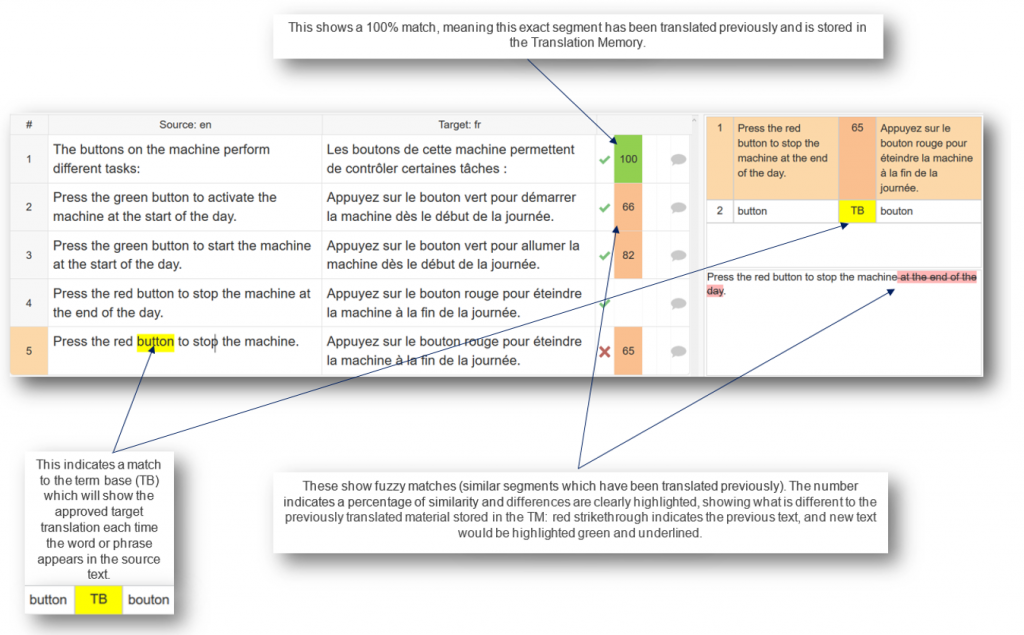Translation Memory
What is Translation Memory technology?
How to successfully balance speed, quality and cost – it’s a dilemma all businesses face. In the translation field, the use of Translation Memory (TM) software, which contributes to improvements in each of these three vital areas, is relatively widespread among language service providers. So why is it sometimes shrouded in secrecy? Here we look at what a TM is, what it isn’t and how it can benefit your translations.
TMs are beneficial throughout the translation process, from the very first step of quotation right through to delivery of the final project itself. Based on the simple idea of a bilingual database, a TM saves a linguist’s translations as they work through a project, securely storing this translated material in segments. These segments can contain phrases, sentences or whole paragraphs, and are stored with the original source alongside the translated target text in bilingual table format. Its advanced algorithms distinguish between contextual matches, exact matches, and similar segments which are also known as fuzzy matches. Much like the role predictive text plays on a mobile phone, a TM acts as a contextual prompt and productivity aid by displaying previously translated material. Below are some examples of a TM system that a translator would typically see in different parts of the user interface:
What can Translation Memory technology offer you and how can you leverage the most from it?
From a cost perspective TMs are a blessing, as repeated and previously translated content is often charged at a lower rate than new content. Companies who translate large amounts will see the Translation Memory drive costs down further, as more translated content ultimately means more stored in the TM and a higher chance of a TM match. Another benefit often left unnoticed is that of consistency: TMs can bridge the gap between projects or stylistic differences if multiple linguists are working on related texts, ensuring the outcome is quality and uniform.
There are a number of things that a Translation Memory can do including cut costs, give context and catalyse the translation process. There are however also a whole host of things that it can’t and won’t do. Clients who worry that it is essentially machine translation should rest easy: whilst advanced TMs can incorporate this capability, they harness the power of machine processes but human input is still very much central, necessary to translate new material, accept previous translations or adapt them as appropriate.
Another thing a Translation Memory tool won’t do is make your data available in the public domain, so the use of TMs throws up no confidentiality issues whatsoever. Most important to point out is that a TM is in no way a stagnant pool of data. Many clients fear that TMs simply store data, resulting in translations that may be outdated or incorrect. If you’re dealing with a communicative language service provider (LSP), this couldn’t be further from the truth. TMs are ever-evolving in line with clients’ preferences as they can be updated retrospectively to take client feedback and changes on board. Some systems are so customer-focused that LSPs can open them up to client reviewers whose amendments will be updated in the TM in real-time.
When it comes to TMs, customisation is key trumps the cliché customer is king. Communicate with your translation account manager. Feed any changes made back to them so that your TM can be updated. If you have local offices using the target languages, put them in touch with your LSP so they can offer suggestions on terminology and linguistic preferences and discuss the prospect of opening up the TM to them. TMs can increase productivity and quality whilst driving down cost, but working together with your LSP will ensure it is exactly what it should be: moulded by you, for you.
If you have experience working with Translation Memories, we’d love to hear from you. Or do you want to know more about the process? If so, don’t hesitate to get in touch and we’d be happy to discuss it in more detail with you.

